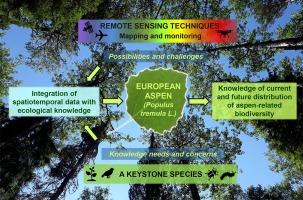当前位置:
X-MOL 学术
›
Forest Ecol. Manag.
›
论文详情
Our official English website, www.x-mol.net, welcomes your
feedback! (Note: you will need to create a separate account there.)
A keystone species, European aspen (Populus tremula L.), in boreal forests: Ecological role, knowledge needs and mapping using remote sensing
Forest Ecology and Management ( IF 3.7 ) Pub Date : 2020-04-01 , DOI: 10.1016/j.foreco.2020.118008 Sonja Kivinen , Elina Koivisto , Sarita Keski-Saari , Laura Poikolainen , Topi Tanhuanpää , Anton Kuzmin , Arto Viinikka , Risto K. Heikkinen , Juha Pykälä , Raimo Virkkala , Petteri Vihervaara , Timo Kumpula
Forest Ecology and Management ( IF 3.7 ) Pub Date : 2020-04-01 , DOI: 10.1016/j.foreco.2020.118008 Sonja Kivinen , Elina Koivisto , Sarita Keski-Saari , Laura Poikolainen , Topi Tanhuanpää , Anton Kuzmin , Arto Viinikka , Risto K. Heikkinen , Juha Pykälä , Raimo Virkkala , Petteri Vihervaara , Timo Kumpula

|
Abstract European aspen (Populus tremula L.) is a keystone species in boreal forests that are dominated by coniferous tree species. Both living and dead aspen trees contribute significantly to the species diversity of forest landscapes. Thus, spatial and temporal continuity of aspen is a prerequisite for the long-term persistence of viable populations of numerous aspen-associated species. In this review, we collate existing knowledge on the ecological role of European aspen, assess the knowledge needs for aspen occurrence patterns and dynamics in boreal forests and discuss the potential of different remote sensing techniques in mapping aspen at various spatiotemporal scales. The role of aspen as a key ecological feature has received significant attention, and studies have recognised the negative effects of modern forest management methods and heavy browsing on aspen occurrence and regeneration. However, the spatial knowledge of occurrence, abundance and temporal dynamics of aspen is scarce and incomprehensive. The remote sensing studies reviewed here highlight particularly the potential of three-dimensional data derived from airborne laser scanning or photogrammetric point clouds and airborne imaging spectroscopy in mapping European aspen, quaking aspen (Populus tremuloides Michx.) and other Populus species. In addition to tree species discrimination, these methods can provide information on biophysical, biochemical properties and even genetic diversity of aspen trees. Major obstacles in aspen detection using remote sensing are the low proportion and scattered occurrence of European aspen in boreal forests and the overlap of spectral and/or structural properties of European aspen and quaking aspen with some other tree species. Furthermore, the suitability of remote sensing data for aspen mapping and monitoring depends on the geographical coverage of data, the availability of multitemporal data and the costs of data acquisition. Our review highlights that integration of ecological knowledge with spatiotemporal information acquired by remote sensing is key to understanding the current and future distribution patterns of aspen-related biodiversity.
中文翻译:

北方森林中的关键物种欧洲白杨(Populus tremula L.):生态作用、知识需求和遥感制图
摘要 欧洲白杨(Populus tremula L.)是北方森林中以针叶树种为主的重要树种。活的和死的白杨树都对森林景观的物种多样性做出了重大贡献。因此,白杨的空间和时间连续性是众多白杨相关物种的可行种群长期存在的先决条件。在这篇综述中,我们整理了关于欧洲白杨生态作用的现有知识,评估了对北方森林白杨发生模式和动态的知识需求,并讨论了不同遥感技术在不同时空尺度绘制白杨的潜力。白杨作为关键生态特征的作用受到了极大的关注,研究已经认识到现代森林管理方法和大量浏览对白杨发生和更新的负面影响。然而,关于白杨的发生、丰度和时间动态的空间知识是稀缺和不全面的。此处审查的遥感研究特别强调了来自机载激光扫描或摄影测量点云和机载成像光谱的三维数据在绘制欧洲白杨、颤杨(Populus tremuloides Michx.)和其他杨树物种的地图方面的潜力。除了区分树种外,这些方法还可以提供有关白杨树的生物物理、生化特性甚至遗传多样性的信息。使用遥感检测白杨的主要障碍是欧洲白杨在北方森林中的比例低且分散,以及欧洲白杨和震颤白杨与一些其他树种的光谱和/或结构特性重叠。此外,遥感数据用于白杨制图和监测的适用性取决于数据的地理覆盖范围、多时数据的可用性和数据获取的成本。我们的评论强调,生态知识与遥感获得的时空信息的整合是了解白杨相关生物多样性当前和未来分布模式的关键。遥感数据对白杨树绘图和监测的适用性取决于数据的地理覆盖范围、多时数据的可用性和数据获取的成本。我们的评论强调,生态知识与遥感获得的时空信息的整合是了解白杨相关生物多样性当前和未来分布模式的关键。遥感数据对白杨树绘图和监测的适用性取决于数据的地理覆盖范围、多时数据的可用性和数据获取的成本。我们的评论强调,生态知识与遥感获得的时空信息的整合是了解白杨相关生物多样性当前和未来分布模式的关键。
更新日期:2020-04-01
中文翻译:

北方森林中的关键物种欧洲白杨(Populus tremula L.):生态作用、知识需求和遥感制图
摘要 欧洲白杨(Populus tremula L.)是北方森林中以针叶树种为主的重要树种。活的和死的白杨树都对森林景观的物种多样性做出了重大贡献。因此,白杨的空间和时间连续性是众多白杨相关物种的可行种群长期存在的先决条件。在这篇综述中,我们整理了关于欧洲白杨生态作用的现有知识,评估了对北方森林白杨发生模式和动态的知识需求,并讨论了不同遥感技术在不同时空尺度绘制白杨的潜力。白杨作为关键生态特征的作用受到了极大的关注,研究已经认识到现代森林管理方法和大量浏览对白杨发生和更新的负面影响。然而,关于白杨的发生、丰度和时间动态的空间知识是稀缺和不全面的。此处审查的遥感研究特别强调了来自机载激光扫描或摄影测量点云和机载成像光谱的三维数据在绘制欧洲白杨、颤杨(Populus tremuloides Michx.)和其他杨树物种的地图方面的潜力。除了区分树种外,这些方法还可以提供有关白杨树的生物物理、生化特性甚至遗传多样性的信息。使用遥感检测白杨的主要障碍是欧洲白杨在北方森林中的比例低且分散,以及欧洲白杨和震颤白杨与一些其他树种的光谱和/或结构特性重叠。此外,遥感数据用于白杨制图和监测的适用性取决于数据的地理覆盖范围、多时数据的可用性和数据获取的成本。我们的评论强调,生态知识与遥感获得的时空信息的整合是了解白杨相关生物多样性当前和未来分布模式的关键。遥感数据对白杨树绘图和监测的适用性取决于数据的地理覆盖范围、多时数据的可用性和数据获取的成本。我们的评论强调,生态知识与遥感获得的时空信息的整合是了解白杨相关生物多样性当前和未来分布模式的关键。遥感数据对白杨树绘图和监测的适用性取决于数据的地理覆盖范围、多时数据的可用性和数据获取的成本。我们的评论强调,生态知识与遥感获得的时空信息的整合是了解白杨相关生物多样性当前和未来分布模式的关键。











































 京公网安备 11010802027423号
京公网安备 11010802027423号